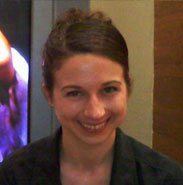Suturing the Wound of Globalization: Immigration and Organs in Dirty Pretty Things
By Abby Hinsman
| “Are those living under conditions of social insecurity and economic abandonment on the periphery of the new world order really the ‘owners’ of their bodies?” |
| –Nancy Scheper-Hughes1 |
The film Dirty Pretty Things, released in 2002, and directed by Stephen Frears, reifies the situation described above by Scheper-Hughes, and raises the question: can social aliens own their own bodies within the framework of narrative cinema?2 Suture, penetration, and dynamics of (in)visibility articulate (when they should disarticulate) the globalized London of Dirty Pretty Things. In relaying a story that addresses the plight of illegal immigrants and asylum seekers in the bordered but interconnected world of late capitalism, the film’s project is frustrated by the presence of voyeurism, the formal tropes of classical continuity cinema, Freudian and Marxist fetishism, and an aversion to the abject. Frears’s movie becomes a crucible for the troubling intersection of narrative cinema with content whose constituent parts prove incompatible with one another: the person marginalized by the nation-state, patriarchal notions of gender and sexuality, and the symbolic order. This cinematic incompatibility can be read as a metaphor for the failings of the nation-state, globalization, and late capitalism to support the existence and incorporation of the human body. In a film that intends to address the adversities faced by illegal immigrants in the U.K., the narrative focus on immigrants who improve their own situations through individual resourcefulness, and the emplacement in the role of villain of an immigrant who runs an illicit business in organs, obscure the global, official, and regulatory forces that define individuals as illegal persons and work to foster demand for a trade in human organs.
Dirty Pretty Things’ thriller-like plot revolves around illicit trafficking in the organs of politically peripheral illegal immigrants and asylum seekers, with transactions occurring in the London hotel that employs individuals involved in both ends of the trade as organ donors and brokers. In fact, the organ broker visible in the diegesis, Juan, is himself an immigrant, implying that the trajectory of the contemporary immigrant is a cul-de-sac. The intrigue involved in such a story easily translates into the genres of suspense and the thriller. Frears has discussed maintaining tension, and, by implication, suspense - both meaning-making devices.3 The forward-moving linear narrative, as it plays on and reinforces traditional viewer expectations for a resolution, constitutes a signifying practice that shores up the dominant order. The director, in an interview for Cineaste, emphasized prioritizing suspense building over stasis: the thrust of the plot in the context of sexual violations acted upon the character Senay (played by Audrey Tautou), the protagonist’s love interest, and a Turkish woman seeking asylum while working covertly as a hotel maid. In his recollection, Frears inexplicably conceptualizes a bifurcation between the film’s plot and the event of Senay’s rape: “I remember thinking something awful has happened to this girl and you have to sort of deal with that, but also you want the plot to keep moving, so I didn’t want the film to stop and become a story about a girl being raped.”4 To Frears’s unsupported assertion that the “plot” must exclude anything that could be construed as digression, or any deviance from what Frears perceives as the a priori narrative, we may ask: why does plot maintain such a stranglehold on his work, especially in a film that allegedly focuses on the unspoken, the subordinate, and the disenfranchised? Frears seems to fear the embodiment of a ruptured, violated (female) body, as if the tearing of flesh will rip the narrative sheath as well. The linear plot of Dirty Pretty Things promotes homogeneity, rather than a feminist or semiotic heterogeneity of meaning, and so the film’s formal organization campaigns against its purported project.
Suture and Seams
Suture, a Lacanian psychoanalytic concept, has been extended and applied to the cinema by Christian Metz (et al) and plays a major role in undercutting the ideological objective of Dirty Pretty Things. It is: “[the] moment when the subject inserts itself into the symbolic register in the guise of a signifier, and in so doing gains meaning at the expense of being.”5 The Lacanian real is replaced with the symbolic — a phenomenon that occurs in the cinema as well. Classical continuity editing and cinematography, as in Dirty Pretty Things, elide space and impart meaning to the shots through suture or cutting, rather than allow action to happen mostly within the frame in a long take, which would permit the viewer’s eye to travel freely over the image. Thus, classical narrative cinema and continuity editing choose for the viewer (e.g., in shot/reverse shot, where the object of our gaze in the initial shot is “sutured” into the diegesis by showing a diegetic character beholding the object in the reverse shot, or vice versa) in order to cover over the lack that always lurks, definitively formless and unseen, outside the field of vision.6 The “imaginary plenitude” of the shot initially experienced by the viewing subject functions in a way similar to the mirror image in Lacan’s mirror stage, wherein the subject creates subjectivity out of her or his reflection in a mirror. This reflection is whole but based on an illusion and therefore fragile; in its wholeness, the mirror image implies the potential loss (castration threat) or lack posed beyond the mirror.7 Suture, the movement from being into meaning, resonates in the marginalized immigrant’s attempts to enter the legality of the exclusionary nation-state, Great Britain. The film uses editing to deny the abject reality of the illegal immigrant’s situation, becoming a fetish to patch up the lack represented by political and economic pariahs. Such a suturing fetish provides agency, an entrée into the symbolic order. For the protagonist, Okwe (played by Chiwetel Ejiofor), a hotel porter and former doctor from Lagos, Nigeria, the practice of medicine and surgery grant agency. Senay, on the other hand, sews in a sweatshop to earn legal legitimacy. As both the suture and the fetish always conceal lack, so they do in Dirty Pretty Things. The sexual violations of Senay, not portrayed onscreen fully, are darkened (as in her rape by Juan) or elided altogether (in the oral sex acts the sweatshop owner forces her to perform).


Above: Senay’s rape
These acts, bereft of celluloid materiality, occupy a suspicious place of textual absence. If shown fully, they may embody rape and lead to a spectatorial discomfort that would upset the imagined notion that sex exists as an emotional and physical exchange between two free equals and is not a commodity. Emily Davis argues in “The Intimacies of Globalization: Bodies and Borders On-Screen,” that the significance and threat of prostitution lie in a capitalist commodification of sex that actually undermines patriarchal notions of sexual love.8 Her observation resonates in these scenes in Dirty Pretty Things because, in these economic transactions, the moments of sexual violation remain invisible.
As a prelude to the first sexual violation, the sweatshop owner intimidates Senay with a story that promises her unending nightly rape in prison where the sexes “mix” in order to coerce her into oral sex with him. He turns Islamic and gendered discourse against her, informing her that if she wants to be like Western girls, that is what will happen. Frears, in commentary, expresses his desire to “hide” what he is conveying in this scene, supposedly to encourage use of the viewer’s imagination rather than explicit portrayal. Frears’s directorial decision refuses Senay’s sexual act onscreen realization; ellipsis and implication substitute for direct confrontation with the violation, which might soil the sexual “purity” of Senay as a character and her status as an erotic object for viewers and Okwe. The prudish neglect of this plot point denies its importance to her character and denies her narrative agency in favor of a traditional love story that empowers Okwe to save her from another bodily violation: that of kidney removal by Juan. By not showing the sexual act, suture preserves the stability of the viewer’s identification with and investment in the narrative, and avoids destabilizing the narrative’s (thriller, romantic) thrust through visualizing an act of such traumatic violation. In relegating the action to off-screen time, Frears subordinates Senay’s experience to the dominant male narrative. The director suppresses and sutures over the violation; montage pushes it outside of narrativity.
The second oral sex scene is fractured: the viewer does not see Senay and the sweatshop owner in the same shot (e.g., a medium or a long shot) during the act. The cinematography only shows her preparing in close-up, then his pleasure, followed by his pain in shot/reverse shot formation.
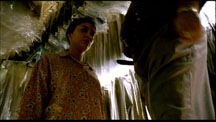

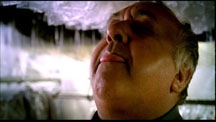
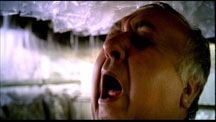
These scenes also demonstrate the lack not only in signifying Senay’s castrating encounter with rape (as castrating subject and object: she castrates her employer quite literally, but that she is forced into that position strips her not only of political, but also of sexual agency), but in her deprived status as an asylum seeker, a consequence of globalized capitalism. By refusing complete portrayal of the sexual act in the shot, suture cuts out some of the most exploitative and castrating aspects of life as a refugee in a Western state - for fear of hijacking a plot that the director wishes to remain dominated by the conventional and profit-generating romance and thriller genres. This project is evident in Frears’s professed anxiety over the potential of these scenes to devour and usurp the plot vehicle, and make the film ultimately about Senay’s rape, rather than adhere to the original plot premise concerning illegal immigrants and organ trafficking, presided over by Okwe, a male protagonist.9 The tenacious patriarchal fear of the devouring power of female sexuality and the female reproductive body, as they represent difference and lack, is confirmed by the director’s extratextual commentary and the mechanism of suture.
Besides its formal manifestations, literal suture, as stitching or sewing, appears in the diegesis of the film and within the shot on at least three occasions. First, when the mortuary attendant and Okwe’s friend, legalized immigrant Guo Yi, sews up the pockets of the suit on a corpse, the film aligns the immigrant with the abject body.

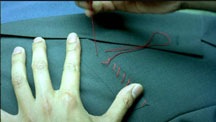
Above: Stitches provide a diegetic, literal suture.
According to Julia Kristeva in Powers of Horror, culture associates the abject with the female reproductive and sexual body and threatens subjectivity, identity, and power.10 Western societies would like the abject, with its subversive effect on cohesive identity, to remain invisible to citizens of the state. So, the immigrant, Guo Yi, provides the suture to sew shut abjection’s menacing maw. Second, as a sweatshop seamstress, Senay’s labor supports the international textile industry. Illegal immigrants, while meant to be invisible, create the seams to undergird the globalized network of industry, trade, and capitalist endeavors. Third, Okwe performs the suturing process literally: by stitching the gaping holes in bodies of illegal immigrants after they have undergone organ removal (even that of Juan), he covers the wound of displaced castration. He also sutures figuratively by covering over the gross social, economic, occupational, and familial deprivation he has suffered as a casualty of globalized capitalism and the power of the nation-state. Okwe seeks to conceal, rather than expose his loss of power and agency (castration). The protagonist’s efforts constitute a figurative suture because he strives to work with, rather than against, boundaries of legality set by the nation-state. Gilles Deleuze has formulated these boundaries as subtending “striated spaces.”11 Deleuze formulates striated space – that of the nation-state – as bordered, regulated, and distinct. Conversely, undifferentiated, continuous, amorphous, and undefined “smooth space” exists beyond the purview of the nation-state. Striated spaces, necessarily constructed, must be heavily policed by the state.12 By obeying the dictates of striated space, Okwe attempts to remedy his loss and avoid further rupture, which outright rebellion might cause. He does this by holding multiple jobs at undue burden to himself, working to sustain the hygienic conventions of proper medical practice and procedure in high-risk situations that are themselves direct outgrowths of globalization, as well as by becoming an agent in global organ trafficking when he removes Juan’s kidney. Okwe upholds the social and legal orders by attempting proper medical practice, urging Senay to save money for a passport, and refusing to partner with Juan in illegal organ trade. However, his existence turns on the fetishist’s disavowal, “I know very well, but all the same,” on which Laura Mulvey has extensively written in the context of cinema.13 Mulvey’s examination of the two types of fetish, Marxist (commodity) and Freudian (castration/sexual difference), is especially appropriate in its application to the cinema, which incorporates and condenses both fetishisms, and specifically to a discussion of Dirty Pretty Things. In the Marxist fetish, capitalism fails to assign properly the value of labor or production to its product, the commodity. In the Freudian fetish, the lack signified by the mother’s genitalia (perceived as castrated by the male subject), is disavowed through the construction of a fetish that replaces the mother’s absent phallus. Each fetish involves the “disavowal of knowledge in favor of belief.”14 Both are present and overlap in the cinema, where the production of the screen signifier is masked by spectacle, and the lack signified by sexual difference is disavowed through the fetishization of the female star’s body through close-ups and costuming.15 In Dirty Pretty Things, Okwe disavows the fact that the legal and medical systems he tries to obey disempower and eject him and Senay from the nation-state.
Okwe must castrate and suture Juan within the already established, corrupt system of bodily commodification (itself a symptom of globalized capitalism), in order to protect himself and Senay from further loss. This plot point inhibits the ability of the film in exposing and effecting change in the dire situations of illegal immigrants and those deprived by globalization. Instead, by conforming to the formal conventions of closure and change (frequently betterment) in Classical Hollywood cinema, the film appears almost complicit with globalized capitalism. The text creates a fiction in finding, albeit bittersweet, improvements in the situations of its protagonists via their luck and ingenuity: they are portrayed as resourceful enough to become agents of their own change and situational improvement. This maneuver conceals the real material experiences of those so-called “illegal” persons in the U.K. in order to satisfy the demands of a classical narrative.
Surveillance, (In)visibility, and Penetration
While suture works to hide certain features of the illegal immigrant’s life, in Dirty Pretty Things’ tension between invisibility and visibility, government agents attempt to uncover and expose other aspects, namely those pertaining to the immigrant’s relation to the state. The unveiling and discovery work conducted by the camera become signifying practices that necessarily involve some form of penetration, visual at the minimum. Dirty Pretty Things manifests surveillance in two forms: striated spaces and the panopticon. The film is set on the threshold between smooth and striated space as the illegal immigrants attempt to legitimize their existence by obtaining citizenship, illuminating the material hardships endured by those who must live undetected in striated space. Through observation or the known possibility of observation, the panopticon effects control over its inhabitants.16 Surveillance cameras make the illegal immigrant visible by documenting hotel workers, especially the maids, as they enter the hotel for shifts, a probing that implies not only that the state seeks control of the immigrant body, but of the female immigrant body especially. Senay directly looks into the surveillance camera as she enters for her shift, indicating the panopticon’s efficacy: she is fully aware that her body may be under surveillance by the state at any time or in any place, even in the privacy of her apartment.
The Immigration Enforcement Directive, a state-controlled organization that seeks control of the borderline, indistinct inhabitants of London, continues the voyeuristic and sadistic treatment of the female immigrant. In a charade that thinly veils the repressed discovery of sexual difference, the Directive’s male agents invade Senay’s apartment and rifle through her personal belongings on the pretense of checking up on an asylum seeker (Senay is not allowed to work or accept money while seeking asylum, including from a sub-letter like Okwe). The agents’ official status – sanctioned by the state – is signified by their badges, which they flash whenever they may be encountering someone like an illegal immigrant who discloses the artificiality and fragility of the state’s striated space. When they violate Senay’s privacy in the name of the state, they intimidate her physically and claim a woman “in [her] position” could be “exploited.” In invoking such gender and power charged language, they extract information by attempting to forge a deceptive identification with Senay, while at the same time betraying the falsity of their rhetoric by penetrating her private space.
While Senay’s invisibility is made visible, Okwe’s nuanced manipulation of visibility allows him to remain unseen in ways that matter to the state. For instance, his successful disguise as a hospital cleaner in order to obtain antibiotics speaks to assumptions about the identities of the working class, namely, that they would not be medically trained doctors. As someone who also depends on surface invisibility, Juliette speaks to Okwe about her occupation as a British prostitute, saying, “I don’t exist, do I?” She represents sex as a commodity (perhaps sex out of place), and she should remain hidden within the hotel because her status rejects the culturally assigned emotional import of sex as a gift rather than an exchange of value.17 Prostitution challenges traditional gender roles because women may (certainly not always) exercise sexual and economic power in the same transaction. Transactions that subvert the dominant cultural conception of sexual relations must be conducted sub rosa, as in Dirty Pretty Things, or they will be snuffed out by the state.
Visibility frequently leads to physical penetration, as spectators encounter direct or displaced (onto a nonsexual site of the body as in organ trafficking) rape as outgrowths of globalization. As Davis writes, the female protagonists are most susceptible to penetration; the male protagonists, like Okwe, manage, for the most part, to elude it.18 Thus, the film subscribes to classical cinema’s traditional sadistic and misogynistic impulses. However, the Somalian man who suffers from an infected surgical wound after kidney removal shows that, according to the film, woman’s is not the only rapable body: the African man is also rapable. Scheper-Hughes argues that the positions of donor and recipient in organ transplants are gender-charged: “In fact most kidney sellers are women trying to rescue a husband... Underlying it is the logic of gender reciprocity: the husband ‘gives’ his body in often servile and/or back-breaking labor, and the wife ‘gives’ her body in a mutually life-saving medical procedure.”19 Dirty Pretty Things feminizes the body of the African man and shows him to be excluded from the symbolic order along with women.
The body can be thought of as a Deleuzian striated space in that its borders are patrolled by the state in laws restricting the buying and selling of it. However, these borders can also be exposed as fictitious through the illicit buying, selling, and trading of body parts. Scheper-Hughes writes on the porous nature of constructed borders: “Cultural notions about the dignity of the body and of sovereign states pose some barriers to the global market in body parts, but these ideas have proven fragile.”20 The penetration of the body involved in organ trafficking, a displaced violation of the borders of the nation-state, is a subversive act that circumvents the hegemony of striated space. Organ trafficking threatens the symbolic order by crossing and dissolving fragile biological and national borders. Additionally, Senay’s body and sexuality are disputed territory between Juan and Okwe: the controversies of globalization materialize in the territories of gender, sex, sexuality, and the body — especially the female body. Okwe “saves” Senay from Juan after she trades her virginity and promises one of her kidneys to him for a passport; Okwe avenges her sexual loss and prevents the loss of her kidney. Only when Senay’s body is imperiled does Okwe act or feign participation in Juan’s illicit business in human organs: he demands of Juan a passport and a new identity in return for performing the kidney removal on Senay. If we consider the placement of the two potential bodily losses within the structure of the linear narrative where the stakes increasingly ratchet up in a climactic progression, Dirty Pretty Things seems to argue that a potential kidney excision, as the major corporeal loss avoided by action on the part of the male protagonist, is more significant as a displaced penetration and castration than actual sexual violation. This is suggested by the textual treatment of Senay’s coerced rape, which results in the loss of her virginity, as a less visible prelude to the threatened removal of her kidney.
The Dirt Beneath the Fetish
In some ways, the title of the film, Dirty Pretty Things, and its visualization do more than the narrative to subtend the violent polarities of existence as an illegal. The opening credit sequence presents a clash of “dirty” as the modifier for “pretty” in the style of the words displayed: a white, block typeset superimposes upon a bleeding, red, fractured, and dissolving typeset underneath. The juxtaposition of the words with the concepts connoted through the form of the typeset provides a visual metaphor for the falsely glittering fetish of late capitalism that covers and cites an abject lack: the experience of illegal immigrants, refugees, and those seeking asylum in globalized London. The tandem operation of fetish/lack-abject develops in the course of the film through narrativity, narrative, cinematography, and editing. Mary Douglas, in Purity and Danger, explains the concept of dirt as taboo, something out of place that upsets order, boundaries, and civilization: “Dirt offends against order.”21 Kristeva’s discussion of the abject in Powers of Horror develops further some of Douglas’s theories. The action of warding off what is taboo, dirty, cast out of the body, or reminiscent of the maternal body protects subjectivity in reenacting its creation, and wards off a lurking, incestuous desire to remerge with the maternal body.22 Culture renders the maternal and female reproductive body abject, a locus of concurrent desire and revulsion. Dirty Pretty Things, too, maintains an ambivalent and contradictory relation with the abject, which mars its desire to foster change and identification with the excluded, abjectified person. Toward the beginning of the film, a heart plugging the toilet of a luxury hotel reifies the abject, or the dirt: it is an organ out of place. Stuck in a vessel that contains waste and conducts it out of sight, the disembodiment of the heart serves as the inciting incident of the plot. The film affiliates the immigrant with the abject through occupation: as cleaner of waste, dissolution of bodily borders, and illegal status with regard to the nation-state. The excremental (dis)placement of the illegal immigrant’s heart into the toilet communicates that in relation to the nation-state, the illegal immigrant is waste.
And who better to dispose of that waste and to risk bodily contamination than another illegal immigrant? Okwe, as an African man, is a cleaner of waste, rather than someone who is clean, as in the scene where he unplugs the toilet by removing and containing the biohazardous heart. Okwe places a plastic bag around his hand to control his contact with the threatening abject. When he fastidiously brushes off his hotel uniform, which conceals his lack of means, he also displays an interest in keeping clean the items that interact with his body. The film continues to align Okwe with the role of cleaner by showing him ironing and cooking in Senay’s apartment. Here, he disguises himself as a hospital custodian in order to obtain antibiotics, striving to uphold the codes of proper medical hygiene through prescription of antibiotics, suturing wounds, and sterilizing the instruments and the room for Juan’s kidney removal.
The other immigrants in the film share Okwe’s position as cleaner. Juan, the hotel manager, drives into the hotel garage in his Mercedes, a capitalist symbol of wealth and success, but then immediately picks up trash from the ground and deposits it in the dumpster. The figure of Juan contrasts expensive commodities with trash and the urban underbelly. Although bearing the trappings of wealth and success, Juan remains intimately connected with the illicit subculture of the “dirty,” dispossessed, illegal immigrants in London. Yet even in his contact with the dirty, Juan aids the state by organizing dirt and hiding it from society’s sight. Guo Yi’s occupation processing cadavers and burning the bodily waste in the mortuary brings him closer than Juan to the abject. Whereas Juan deals with trash or waste, Guo Yi deals with the corpse, which Kristeva defines as “the utmost of abjection.”23 Kristeva ranks the corpse as more menacing than other forms of the abject because it “is a border that has encroached upon everything. It is no longer I who expel, ‘I’ is expelled.”24 The corpse, unlike dung or trash, cannot be separated from the subject’s identity and cannot be cast off because it is coterminous with the subject’s body. This poses the ultimate hazard to stable subjectivity and accounts for Guo Yi’s concealment in the bowels of the hospital, where he works in isolation with corpses and medical waste, that which is kept invisible to most of society for the sake of order and avoiding contamination of culture. His job is to cover up the abject, get rid of it, and relegate it to its proper, invisible place before it disrupts the cultural fictions of integrated identity and the whole and closed body.
The film communicates that immigrant bodies exist in a liminal state, as intermediaries who negotiate between the abject and civilization. Perhaps Dirty Pretty Things construes the illegal immigrant as dirt as well: a person out of place in his or her relation to the state, who, by definition, resists proper integration into the cultural body. This is not the immigrant’s doing, but results from the bordered structure of nation-states. The illegal immigrant’s position as “out of place” testifies to the failure of these constructions. Ironically, an organ from an illegal immigrant proves culturally assimilable, even desirable, and less easily detected by the English population than its whole immigrant body. Nonetheless, the film exhibits some discomfort with the body when it begins to erupt. As the diegesis remains circumscribed within the illegal immigrants’ experience of London, this discomfort always presents itself when the cinematic text confronts a marginalized person whose bodily surface has broken as the result of a direct or a displaced sexual act. According to Barbara Creed’s interpretation of Kristeva’s theory of the abject, the emanation of bodily fluids, or any breach in the body’s surface, disintegrates the artificial boundaries created by the symbolic order between outside and inside; feminizes the body by marking its connection to nature and birth; and flouts the illusory integrity of the body.25 After her rape by Juan, Senay lies with blood spattered discreetly on her white robe over her pelvic region. Menstrual and violent sexual forms of abjection condense on Senay’s body, and point to her link to nature. The oblique placement of the blood within the frame, however, reveals uneasiness with the fluid, borderless body.
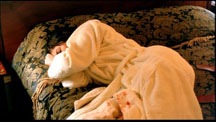
Above: The effects of rape.
Such an aversion to the abject repeats in the narrative and the cinematography. When Okwe examines the symptoms of taxi drivers for gonorrheal infection, the framing excludes the suppurating sexual organs, placing them at a remove behind several barriers. Medical examination occurs down a hall, behind closed doors, and the camera records it through a glass window. The camera is a voyeur, but a prudish one. It signifies, while looking, that the body should be hidden and barricaded against. In return for Amoxicillin, Okwe’s boss agrees to get him all the driving jobs in the city that he wants: payment for prescription medication from a doctor who cannot work in the medical establishment is employment opportunity. Later in the mortuary, Guo Yi quickly displaces a cadaver rolled into the frame as the primary object of our attention and the central figure in the shot. Even when we first see the cadaver, the feet are the only visible flesh (feet are considerably less personal and abject anatomical parts on a cadaver than, say, a head). As the body rolls forward, concealment of the sheet becomes its most important aspect. The camera also shies away from the gruesome and ragged surgical wound of the sick Somalian immigrant who recently had his kidney removed in exchange for a passport. In capturing Okwe’s examination of the wound, Frears invokes rack focus, a technique of suture and an agent of continuity, to shift viewer attention back to the protagonist and the plot, rather than linger on the castrating and potentially distantiating flesh wound.
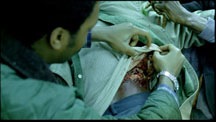
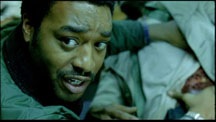
Above: Okwe examines a surgical wound on a Somalian immigrant’s abdomen.
Later in the narrative, Okwe, Juliette, and Senay conduct kidney removal on Juan chiefly beneath sheets, and Frears uses close framing to lend primacy to character development over the content of the action: the traffic in human organs. The camera again seems squeamish with regard to the activity in which these characters who represent the disenfranchised and marginalized of London’s populace are forced to engage. Also, through suture, the camera eschews capturing the incision: before the knife breaks the skin, the film cuts to a reaction shot of Juliette, who also looks away from the violated, penetrated body. Latent castration for the viewer (and maybe for Frears) lurks, literally, in the lack. In this way, the film emphasizes and creates boundaries. Cinematography, editing, plot, and characterization discourage the oozing, bleeding body, while seeking the clean and socialized one. The wound, whether produced by surgery or sexual violation, is sutured out of the filmic text because it embodies sexual difference and the abject, and evokes the fiction of the castrated or, according to Creed, the castrating maternal body.26 In the end, Dirty Pretty Things looks askance at the abject body, and by extension, at the illegal immigrant’s plight, finding them visually and socially disordered.
Like suture, the fetish serves to cover over something threatening – usually the fear of castration – to the subject’s identity. Both the Marxist and the Freudian fetishes are at work in Dirty Pretty Things. The Freudian fetish masks lack (either castration anxiety or the abject), and the Marxist commodity fetish disavows the worker’s labor.27 Juan tells Okwe that the hotel business is about strangers, who come in the night to do “dirty things.” After Senay strikes a deal with Juan to have sex with him and trade one of her kidneys for a passport, he gives her a room at the hotel. Juan and the hotel create a luxurious veneer to cover lack: seamy business dealings in the trafficking of bodily organs, whose commodification is the result of capitalism, rather than of the individual actions of an opportunist like Juan, who also happens to be an immigrant. The sale of their internal organs is so attractive to illegal immigrants because of the way the nation-state fetishizes legal documents: passports, visas, etc. Legal documents come to be overvalued by the immigrant and the state to alleviate the anxiety produced by the non-citizen. The desirability of legal documents reifies citizenship and disavows its artificiality as a status constructed by the state, in the state’s interests, and with little regard for its effects on the bodies it excludes or the price paid by some bodies in order to be included.
In Dirty Pretty Things, nonrenewable organs implicate both the Marxist and the Freudian fetishes. Scheper-Hughes writes that activists view contracts for the removal of nonrenewable organs as unethical because of the permanent damage done to the donors’ bodies and the contextual inequity in which such deals are made. Those deals usually occur among the disadvantaged in terms of gender, race, and class. Women, non-white individuals, and the poor are often the donors.28 The nonrenewable organ as gift comes to be fetishized just as much as the renewable organ as commodity, only the rhetoric of denial goes further. By making the sale of a nonrenewable organ illegal rather than attempting through the market to ascribe a value to it, in a supreme disavowal, the law fails to attach the value of the donor’s labor/sacrifice to the transplanted organ at all. The idea of the organ as gift therefore deviates from the Marxist commodity fetish. When the gift becomes a commodity, as in Dirty Pretty Things, it becomes harder to disavow the labor involved in the transaction. This commodity subverts globalized capitalism and exposes the nation-state as porous. It does this by integrating the supposedly inassimilable body of the illegal into the nation-state in two ways: 1) through her or his organ, which has been transplanted into the body of a citizen, and 2) through her or his acquisition of identity papers. If the commodification of the body’s organs is inherently wrong, the nation-state must consider the wrongness of its more abstracted processes of commodification that hide the worker’s body. Similarly, the Freudian fetish emerges in the wound left by organ removal, a symbolic castration. The wound requires not only literal stitches for healing and hiding the castration, but another form of suture: the social disavowal of organ trafficking, an embodied form of difference. This abject loss originally signified difference in terms of this person’s legal status rather than sexual difference, and so it must be hidden in order for the donor body, an illegal immigrant, to legitimize her or himself in relation to the nation-state.
Ultimately, though, Dirty Pretty Things frames the issue of organ trafficking too narrowly, in a way that undercuts its project. Rather than extending the moral lens to include actors from the dominant discourse (e.g., citizens, figures of legal authority, etc.), the film’s entire narrative takes place on the fringes of London society, on the cusp of striated and smooth space, so positive and negative forces are constructed solely within this frame. In this way, the film striates its own space by closing itself off from a wider societal, or even global, view. Because of this narrow scope, Juan becomes a scapegoat for the social, bodily, and sexual ills visited upon the illegal immigrant. The viewer understands that Okwe is a member of the medical establishment, wrongly ousted, rather than a person rightly excluded. Senay can be reincorporated into the state because of her association with Okwe and her ordered religious ideals. Together they combat the subversive, materialistic, and opportunistic Juan.29 Although Frears portrays him as a wholly despicable character, Juan actually moves outside the boundaries of striated space – the state – and what is sanctioned by legal and medical discourse to forge his own business as an – albeit dangerous – alternative to conclusive and official denial of English citizenship to impoverished immigrants. Juan’s business is a direct outgrowth of the deprivation and lack created by globalized capitalism and striated space, the nebulous and quasi-extratextual villains of Dirty Pretty Things. In giving us an individual antagonist as the object of our negative cathexis, the film conceals a multitude of often faceless, global, economic, governmental, and social factors that contribute to the difficulties in overcoming an illegal status. In reality, the illegal often has no such easy and identifiable adversary.
NOTES
- Scheper-Hughes, Nancy. “The Global Traffic in Human Organs.” Current Anthropology 41.2 (April 2000): 191-224.
- Dirty Pretty Things. Dir. Stephen Frears. British Broadcasting Corporation, et al., 2002.
- Doane, Mary Ann. Femmes Fatales: Feminism, Film Theory, Psychoanalysis. New York: Routledge, 1991. 176-177.
- Lucia, Cynthia. “The Complexities of Cultural Change: An Interview with Stephen Frears.” Cineaste (Fall 2003): 8-15.
- Silverman, Kaja. The Subject of Semiotics. New York: Oxford UP, 1983. 200.
- Ibid. 201-204.
- Ibid. 203.
- Davis, Emily S. “The Intimacies of Globalization: Bodies and Borders On-Screen.” Camera Obscura 21.2 (2006): 33-73.
- Lucia. 12.
- Kristeva, Julia. Powers of Horror: An Essay on Abjection. Trans. Leon S. Roudiez. New York: Columbia UP, 1982.
- Farrier, David. “The journey is the film is the journey: Michael Winterbottom’s In This World.” Research in Drama Education: The Journal of Applied Theatre and Performance 13.2 (June 2008): 223-232.
- Ibid. 227-229.
- Mulvey, Laura. Fetishism and Curiosity. Bloomington: Indiana UP, 1996. 8.
- Ibid. 4.
- Ibid. 2-9.
- Foucault, Michel. Discipline & Punish: The Birth of the Prison. New York: Vintage, 1975. 195-230.
- Davis. 55.
- Ibid. 53.
- Scheper-Hughes. 195.
- Ibid. 194.
- Douglas, Mary. Purity and Danger. New York: Routledge, 1966. 2.
- Kristeva. 54.
- Ibid. 4.
- Ibid. 3-4.
- Creed, Barbara. The Monstrous-Feminine: Film, Feminism, Psychoanalysis. New York: Routledge, 1993. 9-11, 41.
- Ibid. 7.
- Kristeva. 37. And Mulvey. 2-4.
- Scheper-Hughes. 197.
- When Senay offers to sell Juan her kidney, she finds him in his office, looking quite reptilian in a green iridescent vest and a green tie. The film stock has been tinted green as well, carrying with it, in this context, the association of money and greed.
© Abby Hinsman 2010 All Rights Reserved

